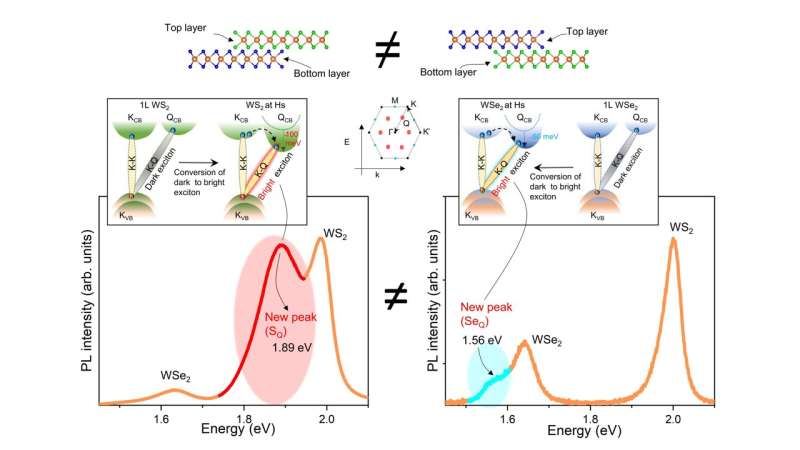This article has been reviewed according to Science X's editorial process and policies. Editors have highlighted the following attributes while ensuring the content's credibility:
fact-checked
peer-reviewed publication
trusted source
proofread
Scientists discover 'flipping' layers in heterostructures cause changes in their properties

Transition metal dichalcogenide (TMD) semiconductors are special materials that have long fascinated researchers with their unique properties. For one, they are flat, one-atom-thick two-dimensional (2D) materials similar to that of graphene. They are compounds that contain different combinations of the transition metal group (e.g., molybdenum, tungsten) and chalcogen elements (e.g., sulfur, selenium, tellurium).
What's even more fascinating is that assembling different TMD layers into vertical stacks creates a new artificial material called a van der Waals (vdW) heterostructure. By incorporating different materials, it becomes possible to combine the properties of individual layers, producing new optoelectronic devices with tailor-made properties. This opens the door to exploring fundamental physics, such as interlayer excitons, twistronics, and more.
However, until now, no scientists have studied whether changing the stacking order affects the spectroscopic properties of these heterostructures. For a long time, the lack of understanding of TMD heterostructures led to a questionable hypothesis that altering the stacking order of the layers does not affect their properties. The study is published in the journal Nature Communications.
This was recently debunked by a team of researchers at the Center for Integrated Nanostructure Physics (CINAP), Institute for Basic Science (IBS) in South Korea. Led by Professor LEE Young Hee the group discovered that the sequential order of the layers in heterostructures affects the generation of "dark excitons" within the material. This finding suggested the added importance of considering stacking sequential order dependence of these materials for further use in real device applications.
Excitons represent an electron and a positively charged hole (a location where an electron is absent) bound together by electrostatic attraction in a solid material, typically a semiconductor crystal. Monolayer TMD semiconductors have a direct bandgap and exhibit optically accessible "bright excitons." At the same time, there are also "dark excitons," that are challenging to study due to their invisibility. However, the underlying mechanisms that give rise to these anomalies are not fully understood.
The IBS researchers observed a remarkable phenomenon: the emergence or disappearance of additional photoluminescence (PL) peaks based on different stacking sequences. This previously unreported effect has been confirmed to be reproducible across multiple heterostructures.
The researchers attributed the origin of these additional peaks to the emergence of dark exciton exclusively located in the top layer of the heterostructure, which is further confirmed by scanning tunneling microscopy (STM). Researchers expect that this property can be utilized for optical power switches in solar panels.

Dr. Riya Sebait, the first author of the study said, "Our experimental results clearly demonstrate stacking sequence-dependent anomalous properties, which could potentially pioneer a new field of study named 'fliptronics.' As we flip or invert the heterostructure, bands undergo a unique renormalization."
A clean, residue-free interface is necessary to investigate stacking sequential dependent properties. This study represents a significant breakthrough as this was the first time. It was demonstrated that altering the stacking sequential order in the heterostructure can lead to changes in its physical properties.
Researchers attempted to explain this flip-induced phenomenon by looking into the microscopic many-particle model, which suggests that layer-dependent strain could be one possible solution to this puzzle.
Assuming that the top layer becomes more strained compared to the bottom layer, the calculated data using the theoretical model shows good agreement with the experimental results. This suggests that this stacking sequence-dependent requires further study, not only for understanding the underlying physics but also for its real-device applications.
Furthermore, this study also facilitates the utilization of momentum-forbidden dark excitons, as due to the unique band renormalization at the heterostructure, it is possible to convert them into bright excitons.
Prof. Young Hee Lee, the main-corresponding author said, "This exceptional phenomenon of the emergence of dark excitons at the bilayer heterostructure will inspire other researchers to delve deeper into understanding and harnessing these extraordinary properties towards applications."
This work was conducted in interdisciplinary collaborations with Prof. Ermin Malic at Philipps-Universität Marburg, Germany, and research fellow Seok Jun Yun from Oak Ridge Laboratory, U.S..
More information: Riya Sebait et al, Sequential order dependent dark-exciton modulation in bi-layered TMD heterostructure, Nature Communications (2023). DOI: 10.1038/s41467-023-41047-6
Journal information: Nature Communications
Provided by Institute for Basic Science





















